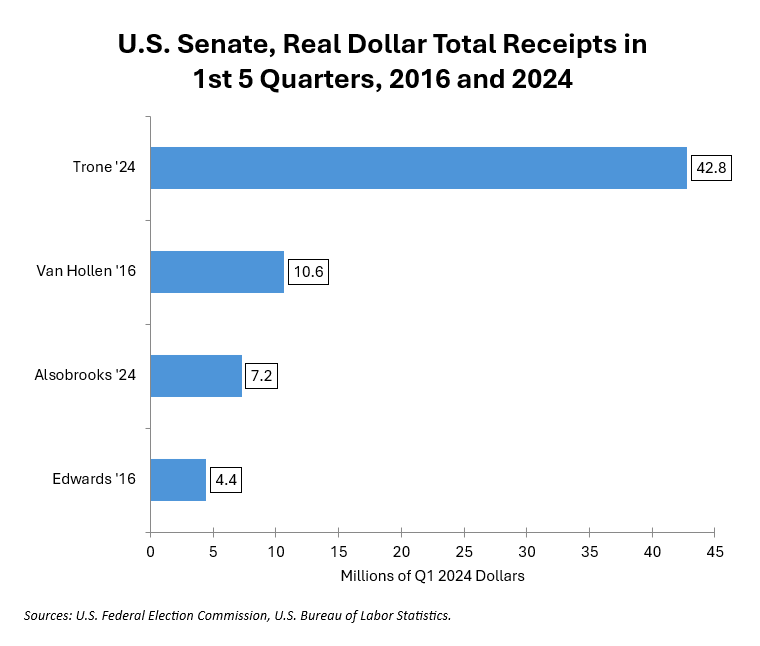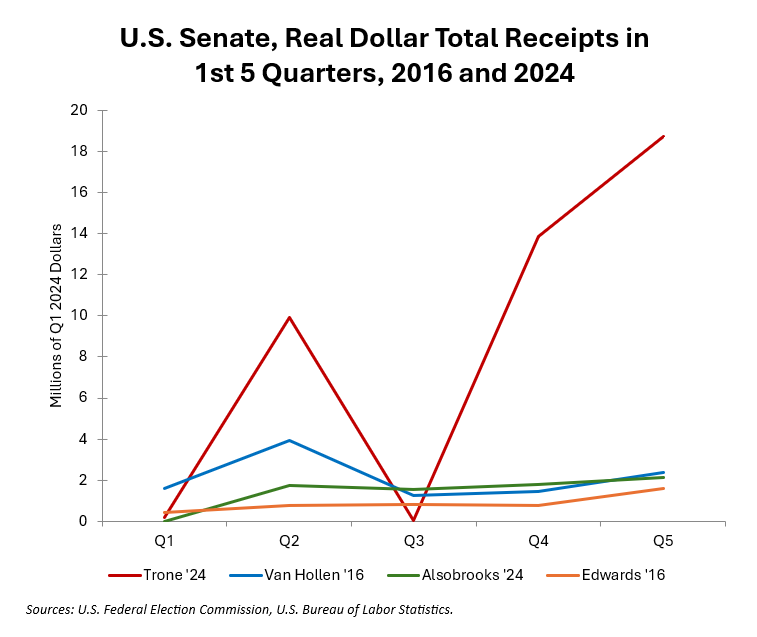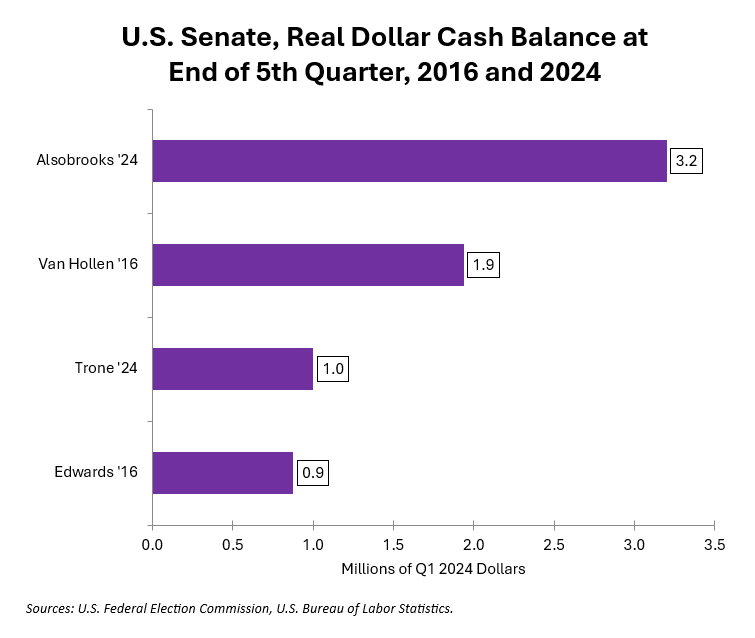By Adam Pagnucco.
Congressman David Trone’s self-funding in this year’s U.S. Senate race is the stuff of legend. According to Open Secrets, Trone is already one of the top Senate self-funders of all time, behind only Rick Scott (FL-2018), Jon Corzine (NJ-2000), Linda McMahon (CT-2010) and McMahon again (CT-2012). Consequently, his primary opponent, Prince George’s County Executive Angela Alsobrooks, has been trailing in every poll conducted so far in this race, although she may be starting to close the gap. No one can outspend Trone, but is Alsobrooks raising enough money to win?
That’s a hard question to answer. But one way to look at it is to compare this year’s fundraising to the last time Maryland had an open U.S. Senate seat – 2016. In that race, long-time incumbent Barbara Mikulski chose not to run again. The two principal Democratic contenders were both members of the U.S. House – Chris Van Hollen (CD-8) and Donna Edwards (CD-4). Van Hollen had been in Congress for seven terms and had chaired the Democratic Congressional Campaign Committee (DCCC) in two cycles. Edwards was a nationally prominent progressive. This was a marquee Maryland race.
In both 2016 and 2024, five quarterly campaign finance reports were due prior to the primary. The candidates’ dates of entry varied. Van Hollen and Edwards both began running in March 2015. Alsobrooks entered relatively late, in May 2023. As for Trone, entry date is irrelevant – how much time does it take to write a check?
In comparing the four candidates, I adjusted all campaign finance numbers with the national CPI-U using a standard of Q1 2024 dollars. This had the effect of boosting the nominal numbers for Van Hollen and Edwards by 31% to account for inflation. The receipts numbers for Alsobrooks and Trone were boosted by 1% to account for slight inflation over the last year. Among other things, this has the effect of accounting for the Federal Elections Commission’s inflation adjustment for maximum individual contributions, as the maximum for 2016 was $2,700 and the maximum this year is $3,300. This is about as close to an apples-to-apples comparison as we can get.
The chart below shows real dollar (Q1 2024) total receipts for the above four candidates for their first five quarters, which essentially covers most of the period leading to the primary.

Trone’s self-funding blows everyone away, including Van Hollen, whose fundraising benefited from his tenure at DCCC. Alsobrooks’s fundraising is between Van Hollen and Edwards. In the world of 2016, Alsobrooks’s numbers would have been competitive.
Let’s break down that real dollar fundraising by quarter.

Alsobrooks got off to a slow start chiefly because of her late entry. But she actually outraised Van Hollen in two quarters and came close to him in the fifth quarter. (She beat him in nominal dollars in the fifth quarter, but let’s remember that we are using real dollars for this analysis.) Let’s just say it, folks – anyone who can keep pace with Van Hollen is doing a good job of raising money.
Now let’s look at real dollar cash balance at the end of the fifth quarter.

Measured in real dollars, Alsobrooks has more cash going into the primary voting period than Van Hollen did in 2016. This is no doubt affected by the respective primary dates of April 26 in 2016 and May 14 in 2024, meaning that Van Hollen’s balance was closer to election day than Alsobrooks’s. Still, this is a good performance by Alsobrooks and reflects sound cash management. She has at least $3 million for the final push, nowhere close to Trone but as good as she could have hoped.
What’s apparent from the above is that Angela Alsobrooks is a pretty capable fundraiser. Add that to the nearly $5 million she has raised during her races for state’s attorney and county executive in Prince George’s County, a place where raising big money is not easy, and her capacity is even more obvious. In a different cycle, she would be the frontrunner.
But what is also apparent from the above is that Trone’s self-funding is otherworldly. He would have blown away Van Hollen in 2016, and let’s remember that Van Hollen had a national fundraising base owing to his four years of leading the DCCC. There are other folks in Maryland who have more money than Trone, but unless one of them runs for office, no one is going to outspend him.
And so we return to the question in this post’s title: is Alsobrooks raising enough money to win? In any other year, I would say yes. This year, I’m not so sure as Trone has built a lead that is challenging (but perhaps possible) to surmount. My hunch is that Alsobrooks will have to do everything right in the final month to pull ahead.
And if she does win the primary, she will have to get right back on the phone to deal with the untold millions of national GOP dollars flowing in to support Larry Hogan.
